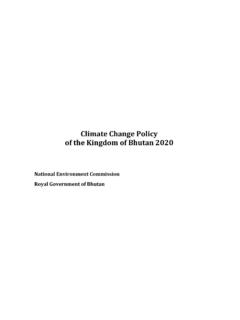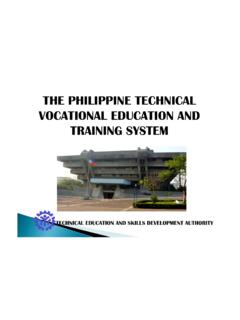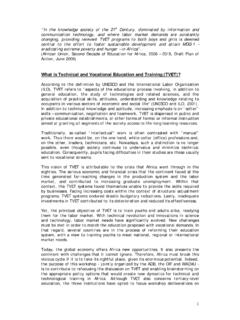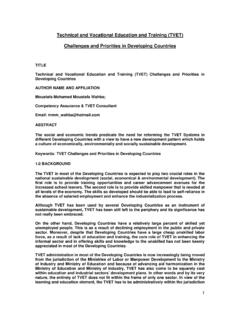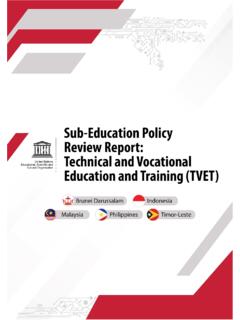Transcription of TECHNICAL & VOCATIONAL EDUCATION AND TRAINING …
1 TECHNICAL & VOCATIONAL EDUCATION AND TRAINING policy FINAL DRAFT Ministry of Labour and Human Resources July 2013 Thimphu. Bhutan TECHNICAL AND VOCATIONAL EDUCATION AND TRAINING policy MINISTRY OF LABOUR AND HUMAN RESOURCES 2 Abbreviations ABSD: Accelerating Bhutan s Socio-economic Development BQF: Bhutan Qualifications Framework BVQF: Bhutan VOCATIONAL Qualifications Framework CBO: Community-Based Organization DHR: Department of Human Resources DoE: Department of EDUCATION DOS: Department of Occupational Standards DTESD: Department of TECHNICAL EDUCATION & Skills Development EDP: Economic Development policy FDI.
2 Foreign Direct Investment FDIP: Foreign Direct Investment policy GTZ: German TECHNICAL Assistance HRD: Human Resource Development ICT: Information and Communication Technology IMB: Institution Management Board IT: Information Technology MDG: Millennium Development Goals MoE: Ministry of EDUCATION MoLHR: Ministry of Labour & Human Resources MSEs: Medium Scale Enterprises MSMEs: Micro, Small and Medium Enterprises NCS: National Competency Standards NEP: National EDUCATION policy NGO: Non-Government Organization NHRDP: National Human Resource Development policy NITE: National Institute of TECHNICAL EDUCATION NLFS: National Labor Force Survey NTTA: National TECHNICAL TRAINING Authority OHS: Occupational Health & Safety PPCP: Public Private & Community Partnership PPP: Public Private Partnership RGoB: Royal Government of Bhutan RUB: Royal University of Bhutan SMEs: Small and Medium Enterprises TTI: TECHNICAL TRAINING Institute IZC.
3 Institute of Zorig Chusum TVET: TECHNICAL & VOCATIONAL EDUCATION and TRAINING UNESCO: United Nations Educational, Scientific and Cultural Organization VET: VOCATIONAL EDUCATION and TRAINING TECHNICAL AND VOCATIONAL EDUCATION AND TRAINING policy MINISTRY OF LABOUR AND HUMAN RESOURCES 3 Table of Contents Introduction .. 4 Scope of the TVET policy .. 4 Vision, Mission, Principles and Objectives .. 5-6 Vision Mission Principles Objectives Access to TVET .. 6-7 Services to Citizens Services to TVET Providers Services to Employers National TVET System.
4 7-12 Bhutan VOCATIONAL Qualifications Framework Educational and Industrial Linkages Curriculum Development Assessment, Certification and Accreditation TVET Providers TVET Infrastructure Public Private Partnership Outcome-Based Approach Instructor Qualification and Professional Development .. 12-13 Financing of the TVET System .. 13-15 Guiding Principles TVET Financing Private Partnership TVET 15-18 International policy Revision and Legislation .. 18 The Way Forward .. 19 TECHNICAL AND VOCATIONAL EDUCATION AND TRAINING policy MINISTRY OF LABOUR AND HUMAN RESOURCES 4 Introduction Bhutan has seen an increased need for technological and industrial skills in the last 10 years, and concomitantly the country witnessed a rapid expansion in TECHNICAL and VOCATIONAL EDUCATION and TRAINING (TVET) providers, especially in the private sector.
5 Yet, a substantial gap persists between the industry skills requirements and the supply of trained and competent human capital. Several national legislations emphasize the importance of TECHNICAL and VOCATIONAL EDUCATION in increasing knowledge, values, and skills of the Bhutanese people thereby leading to the creation of a knowledge-based society. There is the need to strengthen policy guidance and regulatory frameworks for TVET to create a pool of highly skilled, competent, productive, and employable TECHNICAL and VOCATIONAL human resource that is responsive to the changing labor market conditions.
6 The TVET system must create a competent and adaptable workforce to be the backbone of economic and social development and to enable an increasing number of citizens to find gainful employment and self-employment in the different economic sectors. While the Ministry of Labour and Human Resources (MoLHR) acts both as the policymaker and regulator of TVET, the country doesn t yet have a comprehensive TVET policy . Further, the lack of coordination, financing gaps, weak qualification frameworks, and the absence of long-term strategies have hindered the development of TVET in Bhutan.
7 The current TVET system must be scaled up with a particular focus on capacity, quality, and up-skilling. Therefore, the need for a comprehensive national TVET policy is clear and urgent. The policy shall be an umbrella document to guide the overall development of TVET and skills development in the country. Scope of the TVET policy This TVET policy shall cover all occupations in the three sectors of the economy (primary, secondary and tertiary). It covers all levels of VOCATIONAL EDUCATION and TRAINING , and includes in its realm the government, private sector, industry, and NGOs.
8 Within the scope of this policy , TVET may be delivered through formal, non-formal and informal learning arrangements. TVET skills, as understood in this policy , cover the broad set of general skills as well as entrepreneurial skills. The three primary targets of this policy are citizens, employers and TRAINING providers. TECHNICAL AND VOCATIONAL EDUCATION AND TRAINING policy MINISTRY OF LABOUR AND HUMAN RESOURCES 5 Vision, Mission, Principles and Objectives Vision A nation with demand driven and accessible TVET system as a citizen empowerment tool for a quality-assured workforce to enable sustainable livelihoods and socio-economic development of the country.
9 Mission Option 1: To create a highly skilled, competent, productive, and employable pool of TECHNICAL and VOCATIONAL human resource that shall form the bedrock of Bhutan s socio-economic growth. Principles The TVET system shall at all levels be guided by the following principles: Demand-orientation: TVET shall respond to the competence needs and qualification requirements in the labor market and gear towards enhancing the competitiveness of all economic sectors through provision of a competent workforce.
10 It must enhance people s employability in the labor market and promote self-employment. Quality and relevance: TVET shall strive for the highest quality and relevance in all its courses by developing effective means of quality assurance system, continuously monitor the relevance of TVET programs, and provide support and guidance to TVET institutions to achieve defined quality standards. Equity: TVET shall strive for social inclusion by increasing access to relevant opportunities for all target groups, while ensuring equality of access.
